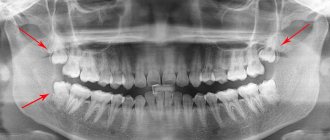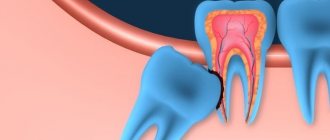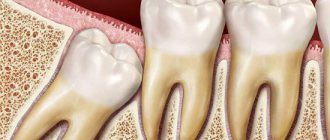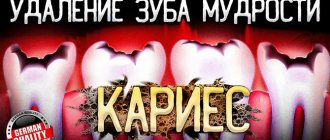- When is it necessary to remove the lower wisdom tooth?
- Tooth eruption problems. Wisdom teeth removal in advance
- Indications and contraindications
- Preparation for the procedure
- Removal steps
- Possible complications after removal
- Time and prices for the procedure
- Advantages of treatment at Aurora
Removal of a wisdom tooth on the lower jaw
Most people of conscious age go to the dentist because of problems with their lower wisdom teeth.
They often interfere, put pressure on neighboring molars, and cause discomfort or pain after eating. Most often, wisdom teeth in the lower jaw appear between the ages of 20 and 25, although the timing varies from person to person; for some, they may appear at the age of 16, for others closer to 40 years. In most cases, the appearance of figure eights is accompanied by various complications that require their removal. Malocclusion, difficulty in teething, tumors and trauma to the mucous membrane and much more.
How long will an extracted tooth hurt?
Removing a wisdom tooth is a serious surgical procedure that severely injures the soft tissues of the periodontium. The fact is that third molars are large teeth, having from 2 to 5 roots. And after their removal, an open bleeding wound remains in the jawbone and gum, which will definitely hurt. And not a couple of hours, but several days.
The pain can be aching and cutting, radiating to the throat or ear. The patient may complain of painful swallowing and persistent headache. An increase in body temperature to 37.5 0C is also natural and physiological. There is no need to endure unpleasant sensations. After tooth extraction, the dentist will definitely recommend painkillers:
- paracetamol;
- ibuprofen;
- analgin;
- butadione;
- sedalgin.
All of them are available without a prescription, are not addictive and have minimal side effects. At the same time, they effectively relieve pain. Normally, the pain at the site of the extracted tooth subsides within 3-7 days. And the final healing of the hole occurs by the end of 2 - 3 weeks after tooth extraction. During this time, she needs to be protected from injury - brush her teeth carefully, eat food carefully.
The appearance of edema is also natural after the removal of the figure eight. As a rule, it forms during the first day after surgery and lasts for the next 2 to 3 days.
If over time the pain does not subside, but, on the contrary, intensifies, you should immediately consult a doctor. Alarm signals are a strong increase in temperature, an unpleasant odor from the hole, acute pain radiating to the temple or ear. These symptoms may indicate the development of inflammation. And without the intervention of a dentist, the purulent process will lead to an abscess and sepsis.
But even if healing goes according to plan, most patients will have to see their doctor again 7-10 days after surgery. This time to remove the stitches. This procedure cannot be called painful, although it is unpleasant. If the patient's pain threshold is too low, the dentist will numb the area of the gum with lidocaine gel or spray.
When is it necessary to remove the lower wisdom tooth?
Eighth teeth are removed in two cases: when they have not yet sprouted or are already protruding from the gums. In the first case, the operation is performed if the patient feels discomfort, and during an external examination the doctor does not see diseased teeth. The appearance of pain means that the molar in the gum is pressing on its neighbor and disturbing him.
If the wisdom tooth has erupted incorrectly - that is, not straight up, but with a deviation, at an angle to the jaw and neighboring teeth, then removal is also a mandatory procedure. The slope of the figure eight is:
- distal - when the “eight” is tilted back, away from the “seven”. In this case, there is a risk of injury to the gums and damage to the roots of the adjacent tooth;
- medial - when the “eight”, on the contrary, is inclined towards the neighboring tooth. This increases the likelihood of damage to the crown part of the “seven” and the development of caries on both teeth;
- buccal – in this case, the wisdom tooth is turned towards the cheek and constantly touches the mucous membrane, causing irritation and hardening of the tissues. This condition can eventually lead to the formation of a tumor on the mucosa.
The removal of a wisdom tooth in the lower jaw is definitely necessary in the following cases:
- Caries on a wisdom tooth.
- Lack of space in the row for teeth. The last molars put pressure and cause discomfort.
- Pain in the gum where the wisdom tooth is located, at any time of the day, even after sleep.
- Incorrect growth sideways towards the tongue or larynx. This phenomenon is called dystopia.
- It interferes with implantation.
A tooth can erupt without causing pain once it appears; it will still be removed because it is not growing properly. The dentist makes an accurate diagnosis. To make an appointment, leave a request on the website or call one of the numbers: +7-924-444-05-45 - administrator
Removing a wisdom tooth in the lower jaw is a more complex procedure than removing an upper tooth. The bottom eights have a more powerful root system, and the jaw bones are denser and thicker. To remove a lower molar, it is necessary to perform a complex operation with dissection of the gum. In some cases, the surgeon has to remove part of the bone, divide the root into several parts and extract them separately.
Sign up for a free consultation
Recovery period
How long does recovery take after removal of upper wisdom teeth and what limitations does it impose? In most cases, after 1-2 days the patient returns to normal life, but sometimes recovery takes longer. To prevent the rehabilitation period from being prolonged, it is very important to follow the doctor’s recommendations:
- take prescribed antibiotics, painkillers and anti-inflammatory drugs;
- do not visit the bathhouse, sauna, swimming pool, or take a bath;
- follow a diet, if possible, eat only soft foods;
- refrain from smoking.
If the doctor did not make mistakes during removal, and the patient carefully followed all the doctor’s recommendations, then the recovery period will pass quickly, and the problem of the upper “eights” can be forgotten forever.
Tooth eruption problems. Wisdom tooth removal in advance
Many patients think that if the wisdom tooth is not visible on the gum, then there is no need to worry. However, over time, this molar increases in size and begins to interfere with the others. Waiting until the wisdom molar appears can lead to the following problems:
- pain in the tooth and gum;
- caries between molars;
- curvature of the roots of a healthy chewing tooth;
- infection in the place where the molar erupts because it grows incorrectly;
- curvature of the bite.
It is easier for a doctor to pick up and remove a tooth that has not yet come out. So while there is no pain, it is better to have surgery in advance.
Indications for removal
Retention can manifest itself as a stage of eruption. Over time, the crown completely appears above the gum and the tooth can function normally. Therefore, the decision on the need for removal should be made by a doctor only after examining and diagnosing the condition of the dental system. Indications for surgery are the following clinical cases:
- Constant pain;
- Complications of eruption;
- Trauma to an adjacent molar;
- Pressure on the dentition and its deformation;
- Horizontal or angular position of the third molar in the jaw;
- Dental crowding, which can be aggravated by wisdom teeth;
- Orthodontic and orthopedic indications, that is, the need for extraction to correct the bite or prosthetics.
Indications and contraindications
The attending physician (therapist) or orthodontist directs the removal of a molar in the lower jaw. In any case, the patient is sent for a panoramic photo, where the location of the teeth is visible. This procedure facilitates the work of the surgeon who has to deal with a complex operation. Contraindications for removal are as follows:
- Pregnancy and breastfeeding. After such a complex removal, the mother will have to stop breastfeeding, because antibiotics and painkillers can get into the baby along with the milk.
- People of the older generation with a diseased heart, hypertension of the 2nd or 3rd degree should be attentive to their health and not rush into surgery, but it is better to refuse it altogether.
- Malignant formation in the tooth growth zone.
Tooth extraction is also done as a preventive measure in advance, so that later they do not hurt and do not interfere with others.
When it is not necessary to delete
There is no need to remove a normally developing, healthy and complete tooth. Usually, eights on the upper jaw have a chance to become this way. Here are the cases in which you can save a tooth:
- there is no interference with normal teething;
- the need to use an evenly grown figure eight as a basis when carrying out certain types of prosthetics. But in modern medicine, this approach is increasingly being abandoned, because the roots of these teeth are weak and cannot withstand the load;
- It is possible to carry out high-quality treatment measures that guarantee a long life for the wisdom tooth.
Preparation for the procedure
Before removing a tooth, it is necessary to undergo a computed tomogram (CT ). The device allows you to illuminate the teeth and see the location of the crowns and roots in the gums. CT will make the surgeon’s work easier and save him from a long and complex operation. The procedure is painless. Done quickly.
The choice of tooth extraction technique depends on several factors:
- the presence or absence of inflammation of the soft tissues surrounding the tooth,
- duration of the process,
- location of the third molar in the bone,
- contacting a doctor during periods of exacerbation or remission of the disease,
- degree of tooth crown destruction.
What drugs are used for pain relief
Just a few decades ago, the only painkiller used by dentists was novocaine. Despite its low toxicity, it very often caused serious complications in patients: from an allergic reaction to anaphylactic shock.
The next step was the use of lidocaine. It is still used to this day in budget dental offices, and has an undeniable advantage: allergies to the drug occur extremely rarely. The problem is different: to prolong the effect of lidocaine, the dentist has to add a drop of adrenaline to it. Moreover, this is done “by eye”. And as soon as the doctor’s hand trembles a little, the patient is guaranteed such unpleasant symptoms as rapid heartbeat and dizziness.
It is much more comfortable for both the doctor and the patient of the dental clinic to deal with articaine anesthetics. These include:
- ubistezin;
- ultracaine;
- septanest.
Firstly, such drugs are administered with a carpule syringe, which ensures that the injection itself is less painful. Secondly, the ratio of adrenaline and anesthetic in the drugs is adjusted to the nearest milliliter. This means that wisdom tooth removal will be painless, and the patient will not experience any side effects.
Important! If the patient is at risk, it is recommended to use an anesthetic that does not contain adrenaline.
Removal steps
The procedure can be divided into three stages:
- preparatory;
- The operation itself;
- After surgery.
Preparatory stage.
At this stage, the doctor visually examines the patient's oral cavity. Then a computed tomography is done to look at the length and shape of the roots, the depth of the tooth, etc.
Surgery
Complex wisdom tooth removal is divided into several stages. Let's consider a generalized operation scheme:
- A painkiller is given. To do this, a needle is inserted into the lower jaw to the nerve bundle so that the patient does not feel pain. Lips, chin, tongue are numbed. If sensitivity does not disappear, an additional injection is given. After anesthesia, the course of a complex extraction procedure depends on the location of the tooth.
- An incision is made with a scalpel.
- The tooth is sawed down to make it easier to remove.
- Take out the crown and roots.
- The wound is treated and sutured.
This completes the surgical stage.
Postoperative stage
This stage is very important, its duration is 7 – 10 days. During this period, the surgical wound heals, and a clot first forms in the hole and then resolves. Patients must follow our doctor's instructions exactly to avoid post-operative complications.
Tooth extraction: how long does the procedure take?
With a simple type of extraction, the procedure is carried out in 10 - 20 minutes. The process of complex removal lasts from 30 minutes or longer, depending on the specifics of the operation. For example, removing a horizontal tooth can take up to 2 hours or more. At the same time, sometimes additional preparatory procedures are necessary, which also take time.
After tooth extraction in the lower jaw antibiotics to prevent the entry and spread of infection. Such complex manipulations are contraindicated for pregnant and nursing mothers. Painkillers are prescribed to reduce pain after the procedure.
For complex removal, the patient is asked to come back again in five days or earlier if a fever appears. If the tooth has come out halfway (semi-retinated tooth), removal is carried out in the same way, but it is easier to pull it out, since part of the molar is on the surface.
Easy removal
If the wisdom tooth has erupted correctly, grows evenly and has straight, untwisted roots, then there is every chance of getting by with a simple operation, which is carried out in 4 stages.
- Diagnostics
, including examination and x-ray, allows the doctor to get a more accurate idea of the upcoming operation. - Anesthesia.
Generally, local anesthesia is used for simple wisdom teeth removal. - Tooth extraction.
The doctor applies forceps, gently rocks the tooth and removes it using a special tool - an elevator. If fragments of roots remain in the hole, they are also carefully removed. - Treatment of the hole and suturing of the gums.
Antiseptic and anti-inflammatory solutions are used. In some cases, stitches are placed to protect the wound from bacteria, and the patient is sent back for rehabilitation. As reviews show, in the case of simple removal it takes very little time.
Possible complications after removal
Complications after surgery arise due to violations of doctors’ recommendations. Patients begin to rinse their mouth, go to the bathhouse, play sports, or do not take medications that were prescribed. It is absolutely IMPOSSIBLE to do this for 5 days, because the place where the tooth was located is easily inflamed. Pain after removal is normal. Because the anesthesia wears off and the gums heal. Taking painkillers reduces pain.
Without taking antibiotics, inflammation and suppuration may begin. This situation arises due to the fact that food often accumulates at the end of the gums, which is difficult to remove with a brush, and along with it remain microbes that cause suppuration.
If bleeding occurs after removal, you should press the wound with a cotton pad for 15 minutes. If the bleeding does not stop, you should consult a doctor.
For reference! For high-quality and rapid healing, it is necessary that the wound heals well, so you should not eat hard food for at least 5 days and clean the hole.
Prevention after surgery
After the last molar is removed, the specialist gives instructions that must be strictly adhered to. This is done to prevent complications, speed up wound healing and restore the body. The doctor recommends:
- Do not eat food for several hours after surgery;
- On the first day, you can apply a cold compress to reduce swelling and inflammation;
- For the first two days, you should not rinse your mouth, so as not to remove the blood clot from the hole from which healing will occur;
- Hygienic care can be carried out as usual; teeth in the surgical area should be brushed very carefully;
- Take painkillers and other medications prescribed by your doctor;
- From the second day, the mouth can be rinsed with antiseptic solutions, decoctions of medicinal herbs, and mouth rinse;
- It is recommended to eat soft foods, avoid too hard, spicy, hot foods;
- Bad habits (smoking, drinking alcohol) should be eliminated;
- During the week you cannot visit the sauna, bathhouse, or gym.
Time and prices for the procedure
This complex operation takes about an hour. The duration of the procedure depends on the complexity of the figure eight position and the degree of neglect.
The consultation is free of charge. The final cost can be found out after consulting a specialist.
| Name of service | Unit | Price |
| Primary appointment (examination, consultation) with a dental surgeon | units | 0 |
| Repeated appointment (examination, consultation) with a dental surgeon | units | 500 |
| Complex tooth extraction with root separation | units | 7000 |
| Removal of periodontitis tooth | units | 2000 |
| Removal of a permanent tooth | units | 4000 |
| Flap surgery in the oral cavity in the area of the 1st tooth | units | 2000 |
| Flap surgery in the oral cavity on periodontal tissues (convet flap displacement) | units | 6000 |
| Removing stitches | units | 200 |
| Suturing the oral mucosa | units | 500 |
| The operation of removing an impacted, dystopic or supernumerary tooth | units | 8000 |
| Stopping alveolar bleeding without suturing using hemostatic materials | units | 500 |
A detailed price list can be found on the website.
Make an appointment for lower wisdom tooth removal
Byshlyaga Dmitry Yurievich
Byshlyaga Dmitry Yurievich Orthopedic dentist
Extensive practical experience. Regularly undergoes internships and advanced training courses.
Working hours: from 9.00 to 20.00, daily, seven days a week, by appointment
Make an appointment
More details
Asatryan Alexander Aramovich
Asatryan Alexander Aramovich Dentist therapist - orthopedist - surgeon
Extensive practical experience. Regularly undergoes internships and advanced training courses.
Working hours: from 9.00 to 20.00, daily, seven days a week, by appointment
Make an appointment
More details
×
Advantages of treatment at Aurora
Removing the lower wisdom tooth is a complex procedure that requires high specialist competence. Due to the inconvenient location and improper growth of the last molar, neighboring teeth suffer. Highly qualified specialists of our center easily and quickly carry out complex operations of this level. In addition, Aurora dentistry has other important advantages over its competitors:
- the possibility of receiving installments from Pochtabank or Renaissance Credit;
- individual approach;
- work on weekends, including for residents of the region by appointment;
- The doctor is assisted by an assistant, which allows him to carry out manipulations 2 times faster;
- modern, 100% high quality, imported materials.
Our dentistry offers the following promotions for the removal of the lower wisdom tooth:
- If you found out about us through 2GIS, we provide 5% on services;
- 10% discount on your birthday and the next 3 days
- For pensioners there is a “Golden Watch” promotion - a 10% discount on tooth extraction from 9-00 to 11-00
If you need complex and long-term dental treatment in Blagoveshchensk, we have an individual discount policy and a flexible payment schedule
To make an appointment, just call. On the appointed day, the doctor will see the patient and tell him how the lower wisdom tooth will be removed without pain after the procedure and fear.
Patient reviews
Review 1
Before describing the procedure, I want to talk about my pain threshold. I can NOT stand pain. At all! I LOVE IT!!! For example, before treating caries, I ask you to give me 2 painkiller injections. And then one day my wisdom tooth began to hurt. I endured it steadfastly! But patience has come to an end! I had to go to the clinic.
Sitting down in a chair, I, as usual, asked for 2 injections and mentally prepared myself for torture :) Instead of somehow supporting and encouraging me, the doctor said: - Nahhh... but the tooth is in an inaccessible place! You can’t even get close to him!!!
Then she asked me to open it wider, then even wider, then again and again... It seemed to me that the corners of my mouth were already torn, and the doctor kept asking me to make my “mouth wider”! At the same time, she said, “What can I do here...” and tried to pick up the tooth with pliers.. These attempts lasted about 5 minutes. There was no particular pain, it was just unpleasant that the doctor could not pick up the tooth and was scared from waiting for the outcome. In the end, I asked: - Maybe I’ll go already?!!! If she can’t pick up a tooth, then WHAT will happen next?! To my deep surprise, the doctor did not even try to persuade me to stay and complete the procedure. She simply said: “Go!”
Well, wow :) This has never happened to me before. Usually doctors persuade: - Well, be patient... If you came, then you need to be patient. And here on you - go... I ask: - And what to do now? The answer was: “Nothing!” Rinse! And don't eat anything for 2 hours. And don't drink anything hot all day. - Why??? - Because the wound should heal. - So you REMOVED my tooth??? - Yes!
Just like that! While I was preparing for “medieval torture” and many hours of torment, the specialist did her job! BRAVO!!! I was delighted! After a couple of hours, the freezing sensation began to subside and the pain returned. She was tolerable, rinsing helped. After a few days the pain went away, but the wound healed for probably a whole month! The pain was weak and dull... The gums ached a little and as if something was pulling. But everything ended well! Everything is overgrown evenly.
Review 2
One of the four teeth had grown into the gum and began to rot there. Therefore, when I came to my favorite dentist, there was only one diagnosis - the wisdom tooth needed to be removed. I honestly couldn’t even get scared when I was already given anesthesia and the fragile dentist started pulling my tooth.
From the sensations, I can’t say that it hurt, no, the anesthesia worked well, but there was a feeling, I felt the tooth being taken with forceps, how it was being pulled, and I was even surprised how my fragile doctor pulled out this chunky tooth. He fought hard to get out, but for professionals there are no problems.
After this, of course, my gums bled a little, I was prescribed mouth rinses so that everything would heal faster. My gums healed within a day. I did not feel any discomfort due to the missing wisdom tooth.
Therefore, I can say for sure that the devil is not as scary as he is painted. Yes, it was unpleasant, but not painful and it could be tolerated. And if I have to remove the rest of my wisdom teeth, I won’t be the least bit upset or scared. Since there is nothing scary in this procedure.










